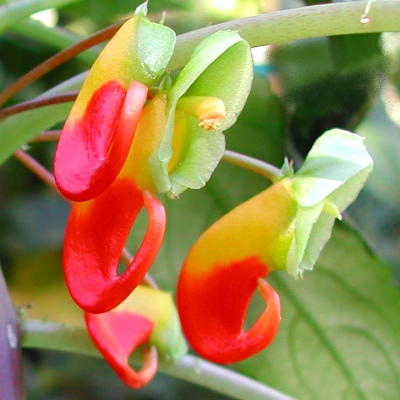Impatiens niamniamensis
Germinating the seeds
When to plant -- Plant your seeds when you receive them for best germination. Getting started -- You may plant each seed in individual, small containers. Or you plant them all in a single container, but it may be more difficult to transplant them later. Either way, use pots with drainage holes. For soil, use a well draining mix. A typical mix is 2 parts potting soil to 1 part
perlite Place a seed in each pot (or if using a communal pot, space them about 1 inch (2.5 cm) from each other). Then sprinkle a thin layer of long-fibered sphagnum moss (not ground peat moss). This helps retain moisture around the seeds while allowing light to reach them, which aids germination. This photo shows how much moss to use. If you don't have sphagnum moss, sprinkle a bit of your soil mix around the surface. Add water until the soil is evenly moist, but not soggy. Until the seeds sprout, ensure that the soil surface never dries out. An easy way to maintain high humidity by enclosing the pots in a plastic container or bag. Leave it open slightly to let in fresh air. Once or twice a day, you may need to drip a few drops of water on the surface to keep it moist. The ideal temperature for germination is between 65 and 77 degrees F (18-25°C). A little cooler at night is ok. Avoid letting them get above 80° F (27°C) for long periods. I recommend placing a minimum/maximum thermometer near the pots. Place the containers in a
bright spot out of direct sun. An LED or fluorescent bulb kept 4 inches
(10 cm) away provides the right amount of light (See: "Growing indoors with LED lights"). Growing onward... Fertilizing -- The first 2 months, feed weekly with a small amount of dilute (1/8 strength) liquid fertilizer. Hydroponic fertilizer is ideal for seedlings, because it is easily absorbed and contains all essential nutrients. After 2 months, you may switch to a granular fertilizer that contains micronutrients, following the dosage on the package. Or continue feeding weekly with some dilute liquid fertilizer. Transplanting -- When your plants are 2-3 months old, you may gently
transfer them to a larger pot. Water the soil first, and avoid letting the
soil ball break apart, which can damage the roots. After transplanting,
give no sun or liquid fertilizer the first week. Above about
40% humidity is best. If your plants seem to suffer from low humidity
indoors, consider using an ultrasonic room humidifier, sold at
home improvement stores and thrift shops. - Jeff Strange Wonderful Things
|
|||||||||


